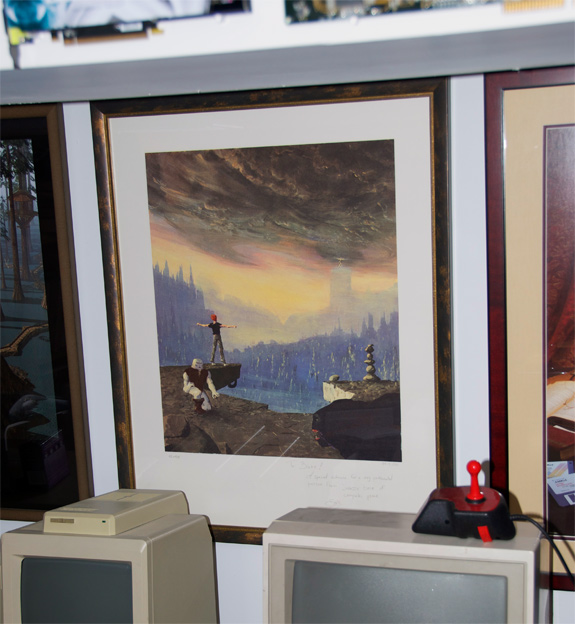- Hack A Day: A Handy Guide to the Humble BBS
- Boing Boing: No Man's Sky as a Commodore Amiga slideshow
- VG24/7: Sean Murray impressed by No Man’s Sky on Amiga computer
- Hack A Day: BBSing with the ESP8266
- Retro Gamer mag: On Being Featured in Retro Gamer’s “Collector’s Corner”
- Polygon: Meet the guy who spent over $4,000 on No Man’s Sky
- NewEgg- HardBoiled: The Science Behind 3 Inspiring PC Battlestations [Archive]
- PC Mag: 7 Amazing Vintage Computer Collections
- CNN HLN: Inside the 'Byte Cellar': 30 years with Apple [Archive]
- Forbes: Steve Jobs In The Flesh
- Lifehacker: The Byte Cellar: A Geeked-Out Ode to Computers and Video Games
- Engadget: Blake Patterson's Byte Cellar: the ultimate man cave for aspiring geeks
- PC World: The Byte Cellar Is the Ultimate Geek Dream Den
- Gadget Review: The “Byte Cellar” Contains 122 Video Game Machines [Archive]
- The Games Shed: Retro Gaming Collections – Blake Patterson – The Retro Story Guy [Archive]
- Apartment Therapy: Blake's Byte Cellar Workstation With 4 Different Monitors [Archive]
- CNN (video): Apple's Mac Turns 25
- Engadget: Apple IIc as a Serial terminal to a Mac Mini
- Newton Poetry: Profile: Blake Patterson of ‘Touch Arcade’
- TUAW: Flickr Find: Digital Steve Jobs on a bookshelf [Archive]
- Cult of Mac: Steve Jobs left an imprint on tech and the skin of some devoted fans
A Look at the Sauciest Magazine I Ever Owned
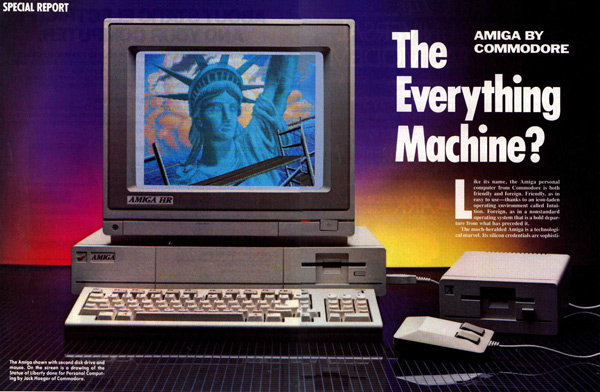
One of the most exciting computers that I ever owned, and certainly one of the most significant in the history of personal computing, is the Amiga 1000, the first Amiga model release by Commodore in the fall of 1985.
At the time of its release, the system featured a powerful 7.14MHz Motorola 68000 processor, on-board custom co-processors to aid in graphics and audio tasks, a UNIX-like, pre-emptive multitasking operating system, and a graphical user interface to tie it all together. The Amiga 1000 unit retailed for $1,295 at launch and was significantly more powerful in every respect than the flagship IBM computer, the PC/AT, which featured a 6MHz Intel 80286 processor and retailed for approximately $6,000.
I learned about the coming Amiga in the summer of 1985, though, sadly, I don’t recall where. It certainly wasn’t “online,” which then would’ve meant on a dial-up BBS of some sort, as I had no modem on the Apple //c I was using at the time. I was intrigued by what I heard and excited about the prospect of owning one. (I was definitely outgrowing that //c.) It wasn’t until I walked into a Waldenbooks and picked up the August 1985 issue of Personal Computing magazine, however, that my lust truly began. And, began, it surely did.
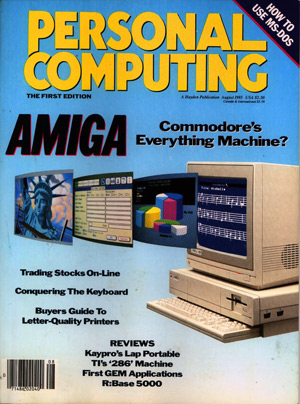 The issue in question featured a striking cover showing the Amiga 1000 unit with several screens of software in action, filing out of the display. Inside, there was a main article and a few associated articles that went into great detail with regard to the system’s capabilities and specifications. I recall finding it actually painful that I was unable to get the text into my brain faster, such was the allure of the machine that was being so clearly described. Geek porn, this definitely was.
The issue in question featured a striking cover showing the Amiga 1000 unit with several screens of software in action, filing out of the display. Inside, there was a main article and a few associated articles that went into great detail with regard to the system’s capabilities and specifications. I recall finding it actually painful that I was unable to get the text into my brain faster, such was the allure of the machine that was being so clearly described. Geek porn, this definitely was.
Remember, younger readers out there, this wasn’t just a faster version of the same old thing, like we generally see with computers today. This was a time when most every new computer brought with it an entirely new operating environment. To embrace a new platform in those days was to venture into unexplored shoals. (It was a thrill I experienced many times, but one that I lament new users today will never know.)
From that day until the day in late October 1985 when I brought my Amiga 1000 home from Chaney Computer in Newport News, VA — the first Amiga 1000 sold in the state of Virginia — I was transfixed by that copy of Personal Computing. I carried it everywhere, even to school, and read it constantly. I read it over and over and lusted and imagined and, in time, I pretty much wore it out. And sadly, like most of the computer magazines I had back in the early days (many of which I’ve reacquired in more recent years), I’m not sure where it went off to.
The degree to which that magazine impacted my life at the time was so dramatic that, a few years back, I sought to locate a copy, to have a look at what it was that sustained me so, until I had my hands on the hardware.  I’ve had an eBay automated search in place for three years, at least, but I’ve never found a copy.
I’ve had an eBay automated search in place for three years, at least, but I’ve never found a copy.
Well, I recently posted a request for the magazine over at Amiga.org and, as good fortune would have it, a reader there had scanned the magazine some years before and was able to provide me with a series of images that captured every page of Amiga coverage in that issue. Hats off, JimS, and many thanks.
In order to share this wonderful bit of computer journalism with others out there, I’ve assembled the various page scans into an ordered PDF that includes every bit of Amiga mention in that 27 year old issue of Personal Computing.
By all means, have a look: Personal_Computing_1985-Amiga.pdf. I found it to be adrenalizing reading and enjoyed the unbelievably impressive bitmaps shown within, including Jack Haeger’s “Four-Byte-Burger.” It turns out that it, and several other works of art shared within, were created with an early version of the Graphicraft paint program — before the program featured a file save option. These images were drawn, photographed, and then cast into oblivion when power was taken from system RAM with the monetary flick of a switch.
Please, do let me know if you happen to recall reading this particular issue, way back when. And, for those that are strangers to that wonderful period in computing history, I hope these scans convey a bit of the excitement that we old geeks enjoyed so long ago.
Update [2022]: I finally, after over a decade of searching, found the physical magazine on eBay and it is now in my hands!

The Apple Game Server Online: Look Ma, No Floppies!
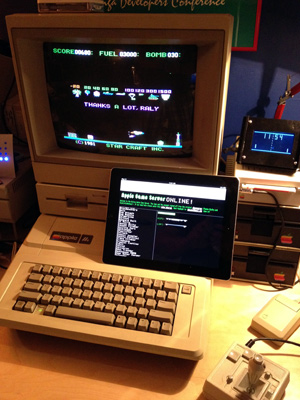 About five years ago I made a post about the Apple II Game Server. It’s a Java application that lets Macs and PCs feed program data into any Apple II via serial null-modem cable — no disk drives required. It’s a terrific effort by creator Brendan Roberts.
About five years ago I made a post about the Apple II Game Server. It’s a Java application that lets Macs and PCs feed program data into any Apple II via serial null-modem cable — no disk drives required. It’s a terrific effort by creator Brendan Roberts.
A few weeks back, Egan Ford, who was inspired by Roberts’ work, assembled a spiritual successor to the Apple II Game Server and placed it online. The Apple Game Server Online is a wonderfully retro-styled website that features a list of Apple II games — now about 200 in number — and associated audio files that contain the audio data from data cassette versions of the games. These audio files can be played back from the browsers of many networked devices out there (like an iPad or a laptop) to load any of the listed games into an Apple II, II+ or IIe when tethered to the vintage Apple’s audio cassette input jack via audio cable.
The drill goes like this: you link your Apple II to the web-enabled host device, type “LOAD” at the Applesoft BASIC prompt, and hit “PLAY” in the web browser. In (usually) less than 20 seconds later, you’re playing a game. It couldn’t be much easier, and the data transfer is not far from floppy speed — and it’s getting faster; Ford has been updating the project earnestly.
From comp.sys.apple2 (usenet):
v0.2 on 12/18:
I updated http://asciiexpress.net/gameserver today. With Michael Mahon’s help I was able to speed up the 12kHz/6kHz 8000 bps HIFI to 12kHz/8kHz 9600 bps. I also fixed a big that effected some games that loaded below $800. Lastly I removed the CRC code in favor of a faster checksum + file length check.
v0.3 on 12/20:
I’ve added a 3rd download option (TRACK). TRACK files are CD compatible WAV files (44.1kHz/16bit) with a modified loader for 11025Hz/7350Hz zeros and ones (8820 bps). I also posted a video of loading a game via a cheap CD player ( http://asciiexpress.net/gameserver/cdload.mp4 ).
Eric Ford’s efforts here join those of Brendan Roberts in contributing greatly to the “Apple II Forever” mindset. As the remaining supply of 5.25-inch floppy disk media and functional, mechanical drives age and dwindle, finding alternatives for program storage must be a priority for the vintage computer enthusiast.
As you can see in the above video, I’ve had fun putting the system (v0.1 is shown) through its paces. If you’ve got an Apple II with a cassette input (any II other than the //c or IIgs) stored away somewhere, don’t miss this easy way to have a little retro fun.
Have a Helping of 8-bit Holiday Cheer! [Updated for 2014]
 I’ve been a computer guy for a long time now, but I’ve been enjoying Christmas even longer.
I’ve been a computer guy for a long time now, but I’ve been enjoying Christmas even longer.
I got my first computer, a TI-99/4A, on Christmas morning, 1982. I was 10 years old, and from that Christmas on, it was games and hardware I wanted Santa to leave me under the tree. On through my teenage years, part of my ritual for getting into the Christmas spirit and enjoying the holidays was downloading and watching Christmas demos on whatever system I had at the time (and every platform out there had a few of them).
Enjoying these demos is a personal tradition that I had, sadly, long left behind until last Christmas when I was inspired to seek out one of the demos I remember best, Audio Light’s 1985 musical slideshow for the Atari ST. With the help of an emulator, I captured it to share online with readers.
Here, a year later, I recently brought it up and watched it run through it’s pixellated images and 3-voice musical holiday greeting. As I watched, it occurred to me that it might be nice to gather a few of the other demos I remember from those good ole’ days and present them here, in order to perhaps share some of the holiday cheer that they used to inspire within me.
The following list of demos ranges across a number of platforms of olde. I’ll start with the Atari ST demo I presented last year. Happy holidays, and I hope you enjoy the shows!
Atari ST: Audio Light Christmas demo (1985)
C64: Seasons Greetings from Commodore (1982)
DOS PC: Sierra On-Line’s A Computer Christmas (1986)
So, Guess What Came in the Mail the Other Day
In late September, Eric Chahi’s superb sci-fi platform action adventure, Another World [App Store], arrived for the iOS platform. I reviewed it shortly before it launched, over at TouchArcade. It was excellently translated to iOS by DotEmu and I gave it a full five stars. If you’re an iOS gamer, it should be on your device.
When Another World landed, I had been eagerly awaiting its arrival since March, when we first heard that it would be coming to iOS during its creator Eric Chahi’s excellent session at the 2011 Game Developers Conference in San Francisco. But, my familiarity with (and love for) the title began much earlier, shortly after its initial release through Delphine, back in 1992. In fact, I had a Mac LC at the time, and when I saw it on my friend‘s DOS PC, it motivated me to go back to the Amiga in order to play it. It’s just a lovely game in all respects.
Not long after I interviewed Eric for my early review post, he contacted me asking for my mailing address. That had me rather curious, and I provided it to him, and the matter passed out of my mind until about three weeks later when I received a cardboard tube in the mail…from France. What I found inside stunned and amazed me. Eric had sent me a rare treasure, indeed.
Eric, who is an artist beyond the realm of game development, wanted to do his own cover art for Another World, and Delphine was cool with it. He produced a stunning oil of an alien landscape featuring our hero Lester in a moment of liberation, standing at the precipice, feeling the wind of an alien world blowing through his hair. I’ve long considered it a very moving piece. And so, apparently, did Delphine CEO Paul de Senneville.
Paul de Senneville was a contemporary art collector at the time, and he was so fond of Eric’s Another World oil that in 1991 he commissioned 120 lithograph prints to be made on acid-free fine art paper. Eric informs me that about 50 of them have been signed and distributed, most of the rest having been lost and forgotten at Delphine. He has been keeping a small number of the prints himself, however, for some “special people,” and he indicates that my obvious passion for the game, along with the photos I shared of my own “Byte Cellar,” inspired him to sign and deliver one of these rare prints to me. I do not exaggerate when I say that, of all the objects in my room of vintage machines, Eric’s Another World lithograph is my most treasured.
Since receiving the print, I have had it framed (notice how the frame matches the clouds…nice, eh?) and found a place for it on the wall of my computer room, alongside my lovely MYST Channelwood poster, appropriately just behind my Amiga.
Thank you once again, Eric.
On the Passing of a Visionary
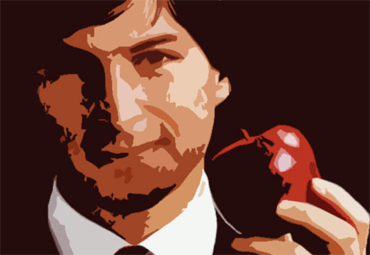 On October 5, now almost a month ago, Apple co-founder and CEO Steven Paul Jobs died of respiratory arrest resulting from a lengthy battle with pancreatic cancer. Of course, everyone reading this post is certainly already aware of it. Steve Jobs has had such a profound impact on my life over the past 25 years, and his exit from this world has been so impactful to me, that I wanted to get into the proper frame of mind and craft a reaction piece that would express my feelings for readers and posterity in a manner that I would deem sufficient, relative to the challenge.
On October 5, now almost a month ago, Apple co-founder and CEO Steven Paul Jobs died of respiratory arrest resulting from a lengthy battle with pancreatic cancer. Of course, everyone reading this post is certainly already aware of it. Steve Jobs has had such a profound impact on my life over the past 25 years, and his exit from this world has been so impactful to me, that I wanted to get into the proper frame of mind and craft a reaction piece that would express my feelings for readers and posterity in a manner that I would deem sufficient, relative to the challenge.
But, it has not worked out like that. Time is passing, I’m not in the proper frame of mind, and I confess I’ve been dreading writing this post. I need to share something, however, and each passing day has made me more ill at ease regarding the nonexistence of this post. And, so, here is a ball of somewhat disjointed thoughts and feelings I’ve been carrying around for the past month regarding a man the world is now without.
Steve Jobs’ death came as a shock, although it should not have.
I was hastily doing some mundane thing or another on my MacBook when I saw the tweets that Wednesday evening. There was no question in my mind that the he was not far from death as I sat there in Moscone West, watching him deliver the WWDC 2011 keynote on what would be the last occasion I would ever seen him in person. Seven years earlier I watched my father-in-law lose his battle with leukemia, and so the transformation I saw Steve undergoing during the last years of his life is one that I had watched closely, before.
 But, still, it was a shock. And, at first, it seemed impossible to believe. A man of such vision, one who had so dramatically affected my own life and who had changed the world we live in — who had handed us the future — how could something so comparatively petty as a failing human body take him away from this world? It did not seem real. These were my thoughts soon after hearing the news of his death.
But, still, it was a shock. And, at first, it seemed impossible to believe. A man of such vision, one who had so dramatically affected my own life and who had changed the world we live in — who had handed us the future — how could something so comparatively petty as a failing human body take him away from this world? It did not seem real. These were my thoughts soon after hearing the news of his death.
As the hours passed, I began evaluating his death in a broader, farther reaching manner. I began thinking of the long path of change that he began cutting back in the ’70s and that continued hazily, beyond our ability to see, far into the future. I began thinking of his critical role, so long ago, at the birth of Apple Computer, Inc. Of his historic visit to Xerox PARC. Of his shaping the Apple //c (the first Apple product I ever owned). Of his creation of the Macintosh. Of his departure from Apple and creation of NeXT, which came to teach him a great deal about humility — an experience that tempered the man. And of his triumphant return to Apple within months of bankruptcy, only to transform it into the most valuable company on Earth. These things, the stuff of epic storytelling. My thoughts here were perhaps less about him as a person and, more selfishly, about myself and humanity and hope for the future.
Later that night, around midnight, I was compelled to drive out to “my” Apple Store, the one located in Clarendon, VA. I felt very lonely and it seemed the obvious thing to do. It was quiet there, but on the door of the stoor I found a bouquet of flowers with a card to Steve. I returned to the store several times over the next few days, for no reason other than that it just felt necessary to visit. I never even went inside. 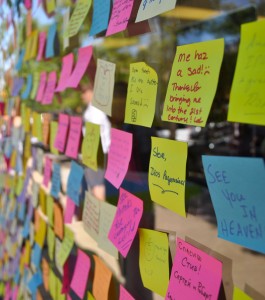 But, over the course of those days the bouquet of flowers turned into a massive outpouring of love and thanks for the now-departed visionary that had touched the lives of everyone who posted a note on that glass storefront. And, these were people that had almost certainly never even met the man.
But, over the course of those days the bouquet of flowers turned into a massive outpouring of love and thanks for the now-departed visionary that had touched the lives of everyone who posted a note on that glass storefront. And, these were people that had almost certainly never even met the man.
The saga of the r/evolution of the personal computer is one I have followed since I unboxed my first, back in 1982. My adventures with my first Apple, which began in 1984, were overwhelmingly fulfilling. From then onward, the technology that Apple brought into the world was a huge part of my life. I didn’t always have an Apple as the years moved by, but I usually did — I usually had several. When Jobs left Apple and formed NeXT, I spent a great deal of time in the bookstore poring over Bruce Webster’s The NeXT Book, lusting after the elegance of the black hardware and its operating system. In college I took out a $5K loan and purchased a then-extremely-high-powered 486 workstation fabricated specifically to run NEXTSTEP for Intel. And, several years later, the very instant that I read the news that Apple would be acquiring NeXT and Steve Jobs to create the next generation Mac OS, my decision to go back to the Macintosh was made. And, here I’ve happily been ever since.
To illustrate the degree to which the creations of Steve Jobs and of Apple have affected my life, I have constructed a timeline of Apple and NeXT-related systems and devices I’ve owned over the past 25 years. I, myself, find the list rather interesting to look at, laid out like this.

The influence that Steve Jobs and Apple have had on my life is not just about the use of the systems they created and how they bettered my day-to-day. They also shaped my professional life.
After working with MacRumors.com for about two years, I started my own blog, iPodHacks.com, that tracked news surrounding the product that marked Apple’s entry into consumer electronics. I started it in 2001, shortly after the iPod was announced, and ran it for basically seven years. From there I co-founded TouchArcade.com, the popular iOS game news and review website, and ran it for three years, like my earlier blog work, as a side-job while working as a web developer during the day, until finally going full time early this year. I have been blogging about Apple products for basically 13 years and it is now my full-time job. Steve and his creations altered the course of my career.
The amount of fulfillment and enjoyment that I have derived from following the saga of Jobs’ work is, happily, not something that I missed along the way. I was quite aware of how fortunate I was to have as my core interest a scenario that excited me so, unfolding around a living legend, and I often expressed this to friends. I lived — we lived — during a time when a giant walked among us, and I feel extremely fortunate to have had the experience.
And, of the future? While Steve Jobs was certainly the dealer of lightning, no one man can bring all that Apple has brought, single-handedly. He returned to Apple and began transforming the company a long 14 years ago. In that time, he surrounded himself with a team that obviously worked, and every success left its mark in Apple’s corporate memory. Jobs brought us this far, and I do truly believe that the machine of innovation he created — twice — will continue reaching into the future and handing it out to us, piece by piece.
Steve Jobs pushed the human race forward. He was crazy enough to think that he could change the world, and that’s exactly what he did.
Thank you, Steve.
The iPod Turns 10 Years Old
 Today is the iPod’s 10th birthday. On October 23, 2001, Steve Jobs took the stage at an Apple Special Event and unveiled to the world Apple’s take on the digital music player, and their entry into the consumer electronics world.
Today is the iPod’s 10th birthday. On October 23, 2001, Steve Jobs took the stage at an Apple Special Event and unveiled to the world Apple’s take on the digital music player, and their entry into the consumer electronics world.
On that day, I wrote the post “Apple’s New Thing (iPod)” on MacRumors.com. Noting the iPod’s extraordinary success over the past 10 years, it’s interesting to look at the user comments on my post. A great many of them are quite negative.
Let me share a few.
Great just what the world needs, another freaking MP3 player. Go Steve! Where’s the Newton?! I still can’t believe this! All this hype for something so ridiculous! Who cares about an MP3 player? I want something new! I want them to think differently!
Why oh why would they do this?! It’s so wrong! It’s so stupid!
All that hype for an MP3 player? Break-thru digital device? The Reality Distiortion Field™ is starting to warp Steve’s mind if he thinks for one second that this thing is gonna take off.
Well, we know how that turned out. In the past 10 years Apple has sold around 305 million iPods, changed the entire music industry, and launched the iOS family of products that sprang from the iPod and iTunes and have changed the face of computing. In short, the iPod was and is a staggering success.
Now, everyone knows that Steve Jobs died on October 5th, and I keep promising to post my Steve Jobs tribute — and I will, soon. But, I wanted to take a moment to salute the iPod here on its 10th birthday. It changed my life in several ways.
The most direct way that the iPod changed my life is by prompting me to, just weeks after the announcement of the device, launch the website iPodHacks.com. I ran the site (alone) for seven years, leaving MacRumors not long after and then, ultimately, shutting it down to move my focus over to TouchArcade.com. As best I recall, I made about 1,800 posts on iPodHacks before I ended it. It gave me the years of blogging experience necessary to have co-founded TouchArcade, and was great fun to run.
Interestingly, just shy of the iPod’s 10th anniversary, iOS 5 launched and the familiar “iPod” icon was changed to “Music,” a signal that contributes to the pool of evidence that suggests that the iPod music player is about to to be put out to pasture by Apple. But that’s no indication of failure — it’s an indication of success and of how the iPod helped push us all into iOS and, really, the future.
The iPod was the start. The iOS family is the present. And the future is ahead of us, but I am rather certain that it will be shaped by the mobile computing paradigm shift that was spearheaded by the iPod.
Happy Birthday, iPod. Thank you for 10 amazing years.
Steve Jobs: Like Comments On Life, Death and NeXT
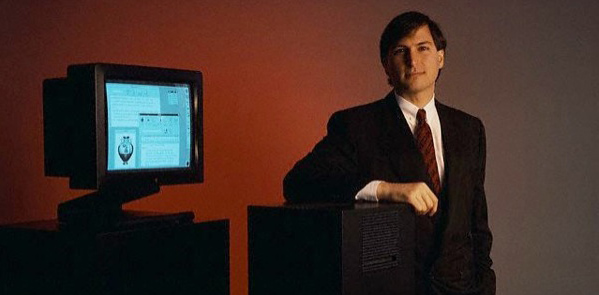
Today I heard the news, like everyone else, that Steve Jobs did not agree to surgery for nine months after learning that he had pancreatic cancer. That news sent me back into the cyclical “what if” thought patterns that I was in for the first week after his death.
Regarding his cancer treatment, Jobs was quoted as saying in a New York Times story posted today:
A doctor told Mr. Jobs that the pioneering treatments of the kind he was undergoing would soon make most types of cancer a manageable chronic disease. Later, Mr. Jobs told Mr. Isaacson that he was either going be one of the first “to outrun a cancer like this” or be among the last “to die from it.”
This immediately reminded me of a commentary he made about NeXT Computer that he founded after leaving Apple in 1986. In the latter days of NeXT (1995), when asked about the goals he had in mind in setting up the company, Jobs stated:
That’s complicated. We basically wanted to keep doing what we were doing at Apple, to keep innovating. But we made a mistake which was to try to follow the same formula we did at Apple, to make the whole widget. But the market was changing. The industry was changing. The scale was changing. And in the end we knew we would be either the last company to make it or the first to not make it.
Unfortunately, he lost on both counts.
But, in the case of the latter, that’s only true as regards NeXT as an independent venture. Shortly after he made that comment, Apple purchased NeXT and, to make a long story short, you are probably running the latest version of the NEXTSTEP operating system in your pocket. Ultimately, there he won.
And, as a result, so did the rest of us.
I Sat At The Retro Computing Roundtable…And It Was Sublime
 I know I said my next post would be my personal tribute to Steve Jobs — and that post is coming — but I had to jump in and share an absolutely exceptional experience I had this past Sunday, with my readers.
I know I said my next post would be my personal tribute to Steve Jobs — and that post is coming — but I had to jump in and share an absolutely exceptional experience I had this past Sunday, with my readers.
I’ve said before that some of the most pleasant experiences that today’s tech provides me — and it’s Apple’s tech that’s really to thank here — is the retro computing podcast. The first such show that I started listening to was Earl Evans’ RetroBits podcast in 2007, and I branched from there to Carrington Vanston’s Apple-centric 1MHz Podcast, and from there I jumped onto many others. I’ve followed these guys onto a number of projects — I have Earl to thank for my Epson PX-8 — and it’s been great.
On Sunday, I had the chance to join Earl Evans, Carrington Vanston, and Atlanta-based computer historian David Greelish (who I pointed to back in August) on their still somewhat new and absolutely exceptional joint podcast Retro Computing Roundtable. It was an honor and an absolute thrill to chat with these folks about that which most fascinates the lot of us: retro computing.
I can’t tell if I should be embarrassed or proud to say that I was so long-winded that they had to split the show into two parts. Let’s call it both, with a smile.
David, Earl, Carrington — thanks so much for having me and I would relish the opportunity to try and wear out my welcome at some point in the future. Actually — to be honest — the podcast was great, but I’d be equally happy with just a group chat, offline sometime. It’s rare that I am able to have dialog with such like-minded, intelligent, and wonderful folks.
Please have a listen: Retro Computing Roundtable (episode(s) 17)
An Apple //c’s Tribute to Steve Jobs
After posting the “Here’s to the Crazy Ones” video the night that Steve Jobs died, I had thought that my next post would have been the one that I very much have to write, explaining what the late visionary has meant to my life, these long years. It’s been difficult to get into a mindset of calm reflection conducive to getting those thoughts out in as clean a fashion as I’d like, and so I’m pleased to be able to share a tribute to the man, of a different sort, while I wait to get where I need to be in order to get out the long, quite necessary piece.
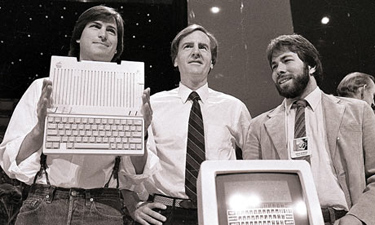 Chris Baird, a regular (cjbaird) in the #a2c.chat IRC channel at irc.a2central.com where I am also a regular, created a rather touching tribute to the late co-creator of Apple in the form of an Applesoft BASIC program. Chris, by a variety of means, took the popular black and white portrait of Jobs and converted it into a series of BASIC DATA statements with a few lines of display code up front. The program, which takes about 15 minutes to fully execute on a stock Apple II, renders the man in 280×192 black and white pixels across the display of any member of the Apple II family.
Chris Baird, a regular (cjbaird) in the #a2c.chat IRC channel at irc.a2central.com where I am also a regular, created a rather touching tribute to the late co-creator of Apple in the form of an Applesoft BASIC program. Chris, by a variety of means, took the popular black and white portrait of Jobs and converted it into a series of BASIC DATA statements with a few lines of display code up front. The program, which takes about 15 minutes to fully execute on a stock Apple II, renders the man in 280×192 black and white pixels across the display of any member of the Apple II family.
I was anxious to see it run on one of my Apple IIs, and I chose the Apple //c on my shelf, as the //c was the first Apple product I ever owned, and Steve Jobs contributed notably to the design of the machine, even while the Macintosh project was underway. The it’s-all-built-in //c was Jobs’ vision of the Apple II as an appliance. (Though, my Ethernet-equipped Apple IIgs was used in the process of getting the disk image from Internet to floppy.)
I recorded a video, most of which is sped-up to help out the //c’s 1.02MHz 8-bit processor, and wanted to share it with those who may not so easily be able to watch this touching tribute “in person.” I have set the video to the Music Recital – Sonata tune from the The Apple at Play demo floppy that came with the Apple //c, pictured. The music you hear was generated on an Apple //c with its meager, stock audio hardware.
A high resolution photo of Steve Jobs, fully rendered on the Apple //c’s display, can be found in my Flickr photoset.

